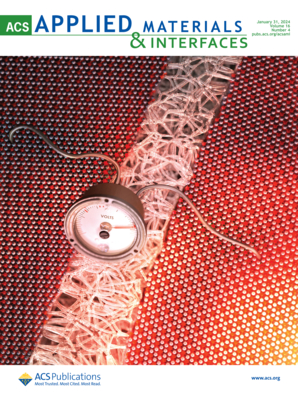Metal Oxide–Metal Organic Framework Layers for Discrimination of Multiple Gases Employing Machine Learning Algorithms
IF 8.3
2区 材料科学
Q1 MATERIALS SCIENCE, MULTIDISCIPLINARY
引用次数: 0
Abstract
The increasing demand for gas molecule detection emphasizes the need for portable sensor devices possessing selectivity, a low limit of detection (LOD), and a large dynamic range. Despite substantial progress in developing nanostructured sensor materials with heightened sensitivity, achieving sufficient selectivity remains a challenge. Here, we introduce a strategy to enhance the performance of chemiresistive gas sensors by combining an advanced sensor design with machine learning (ML). Our sensor architecture consists of a tungsten oxide (WO3) nanoparticle network, as the primary sensing layer, with an integrated zeolitic imidazolate framework (ZIF-8) membrane layer, used to induce a gas-specific delay to the diffusion of analytes, sharing conceptual similarities to gas chromatography. However, the miniaturized design and chemical activity of the ZIF-8 results in a nontrivial impact of the ZIF-8 membrane on the target analyte diffusivity and sensor response. An ML method was developed to evaluate the response dynamics with a panel of relevant analytes including acetone, ethanol, propane, and ethylbenzene. Our advanced sensor design and ML algorithm led to an excellent capability to determine the gas molecule type and its concentration, achieving accuracies of 97.22 and 86.11%, respectively, using a virtual array of 4 sensors. The proposed ML method can also reduce the necessary sensing time to only 5 s while maintaining an accuracy of 70.83%. When compared with other ML methods in the literature, our approach also gave superior performance in terms of sensitivity, specificity, precision, and F1-score. These findings show a promising approach to overcome a longstanding challenge of the highly miniaturized but poorly selective semiconductor sensor technology, with impact ranging from environmental monitoring to explosive detection and health care.

基于机器学习算法的金属氧化物-金属有机框架层识别多种气体
对气体分子检测的需求日益增长,强调了对具有选择性、低检测限(LOD)和大动态范围的便携式传感器设备的需求。尽管在开发具有高灵敏度的纳米结构传感器材料方面取得了实质性进展,但实现足够的选择性仍然是一个挑战。在这里,我们介绍了一种通过将先进的传感器设计与机器学习(ML)相结合来提高化学电阻气体传感器性能的策略。我们的传感器结构由氧化钨(WO3)纳米粒子网络作为主要传感层,与集成的沸石咪唑酸框架(ZIF-8)膜层组成,用于诱导分析物的气体特异性扩散延迟,与气相色谱具有相似的概念。然而,ZIF-8的小型化设计和化学活性导致ZIF-8膜对目标分析物扩散率和传感器响应的影响不容小看。开发了一种ML方法来评估与一组相关分析物的响应动力学,包括丙酮,乙醇,丙烷和乙苯。我们先进的传感器设计和ML算法使我们能够很好地确定气体分子类型及其浓度,使用4个传感器的虚拟阵列,准确率分别达到97.22%和86.11%。所提出的ML方法还可以将所需的传感时间减少到仅5 s,同时保持70.83%的精度。与文献中其他ML方法相比,我们的方法在敏感性、特异性、精密度和f1评分方面也有更好的表现。这些发现显示了一种有希望的方法,可以克服高度小型化但选择性差的半导体传感器技术的长期挑战,其影响范围从环境监测到爆炸物检测和医疗保健。
本文章由计算机程序翻译,如有差异,请以英文原文为准。
求助全文
约1分钟内获得全文
求助全文
来源期刊

ACS Applied Materials & Interfaces
工程技术-材料科学:综合
CiteScore
16.00
自引率
6.30%
发文量
4978
审稿时长
1.8 months
期刊介绍:
ACS Applied Materials & Interfaces is a leading interdisciplinary journal that brings together chemists, engineers, physicists, and biologists to explore the development and utilization of newly-discovered materials and interfacial processes for specific applications. Our journal has experienced remarkable growth since its establishment in 2009, both in terms of the number of articles published and the impact of the research showcased. We are proud to foster a truly global community, with the majority of published articles originating from outside the United States, reflecting the rapid growth of applied research worldwide.
 求助内容:
求助内容: 应助结果提醒方式:
应助结果提醒方式:


